I was looking forward to breaking this night sailing cycle. But this early on in the cruise, I hated the idea of simply wasting a 24 hour cycle, waiting and resting. Besides, more heavy winds were forecasted for 1PM on Tuesday, so I needed to make time and get to Portsmouth. Besides, I got plenty of rest during the day, waiting for the storm to blow over. I talked to my buddy Rob, who lived in Kilmarnock VA, just one creek north of where I was. We were within a mile of each other. We talked about getting him to kayak out to the boat so we could hang out, but it was still way too windy. It was nice talking to a friend, even if it wasn’t in person.
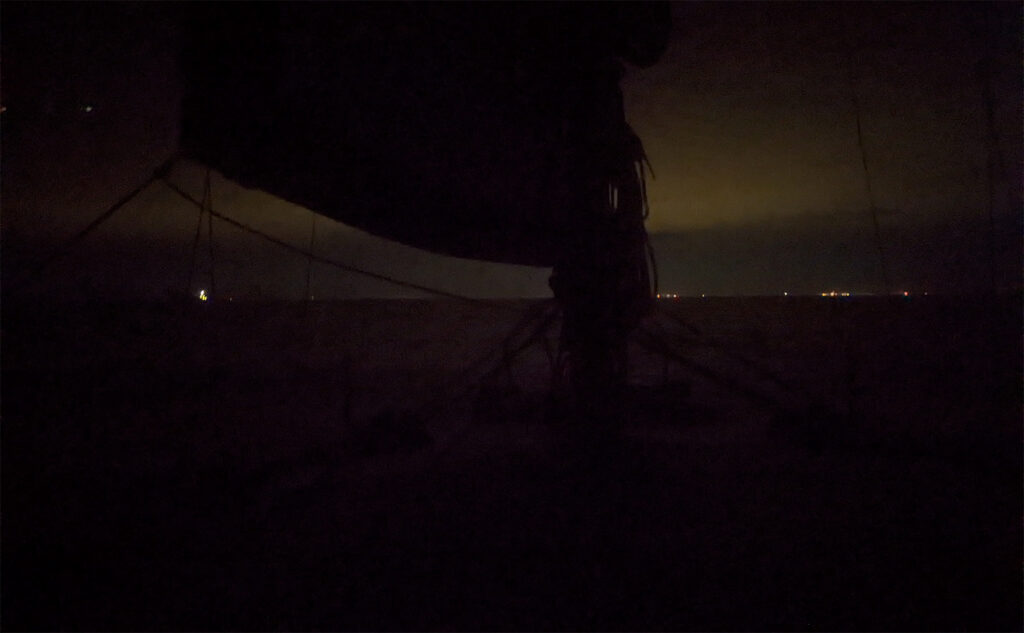
I’d also found out that the storm yesterday was gusting up to forty knots. It was a bit of a relief, because I had been moping around all day, feeling ashamed of my seamanship. Now I felt better about it. There is still a lot of room for improvement, but also a tiny bit of room for pride. I’m definitely not the only one who has gone through these conditions single-handed, but not everyone gets to say they have either.
At nine at night, I left. Winds were still blowing from the north, but was supposed to shift westerly, blowing around seven to eight knots. Then it would shift southerly, from the direction I wanted to go. I wouldn’t have to be stuck in it for too long though, with only the last ten nautical miles or so going against the wind. Then I’d be at my destination.
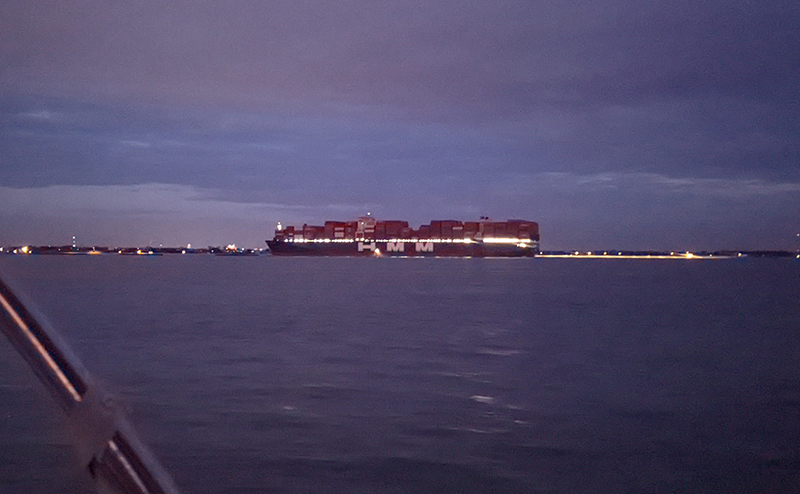
Normally I’ll gladly trade speed to sail, instead of burning gas. Its such a better experience not having the engine drone on and on. But I was still shaken from yesterday, and I was frustrated by my slow progress – I normally do the Norfolk trip in one shot. At most, in two parts. It’d been two parts already and I was barely only about half way through.
A few hours after the winds shifted west, I got my sails up. I discovered that the clew on my 3rd reef point was no longer attached. My shackle pin had come loose and had fallen out! I’m not surprised though, that flogging would have shaken up any shackle pin. Another vote towards not sailing. I wanted the ability to tuck in a third reef if winds picked up again. But I kept my headsail out. With the current behind me and some wind assist, I made five knots at lower engine speeds, boosting my fuel economy. Still, I missed sailing.
The sea state was calm, but there were still residual waves coming from astern (North). Smaller, surface waves were coming from the wind direction. It was a strange sight to look at, but not the first time I’ve seen a confused sea state in the Chesapeake bay. Fortunately, they were all small waves and Sonora glided over them with ease.
One thing I love about night sailing – there is absolutely no recreational vessel traffic. So far, all of the vessels I’ve seen are on AIS, and since they are mostly commercial traffic, they respond on the VHF. The darkness of the night also makes everything seem a bit more silent, calming my noisy mind.
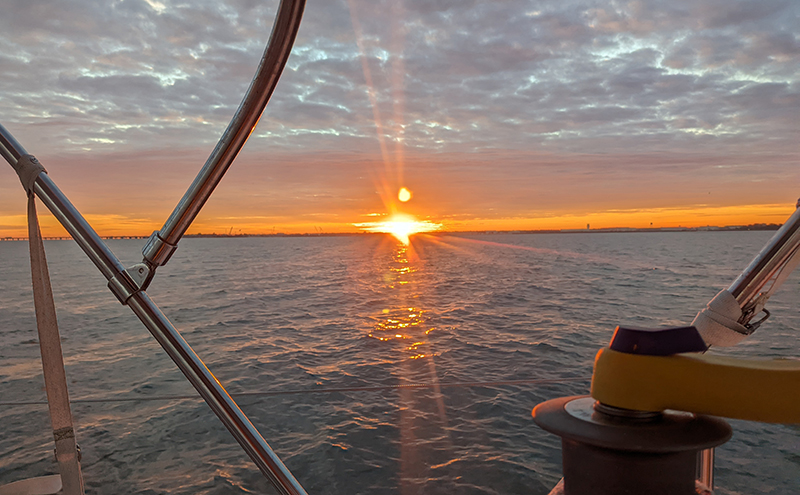
As it got closer to sunrise, the winds shifted southerly. I huddled behind my small, minimalist dodger and tried to stay warm. By now, my body was used to functioning in the cold, but that night was the lowest temperatures so far on this trip. A lot of people describe cold winds cutting through little parts of their cold weather equipment – collars, cuffs and what not. For me, the cold wind seemed to sap the heat from all over my body. I hung on. Eventually, I decided to hop in my cabin. I kept one hatch board in. From there, I could still look at my AIS display, check my charts, and stand up to take a look around. Keeping the body out of the cold wind helped a lot. Worth the trade-off of situational awareness, as long as I stuck to my watch schedule.
As I approached my destination, about twenty miles from the river entrance, I noticed many lights on the horizon off to my port bow. There were a lot of ships in queue, probably waiting to get into Norfolk. I was told later that there were twenty more off of Cape Charles on the other side. All year, there had been shipping bottlenecks causing delays in freight transit. I was told that the actual bottleneck was unionized crane operators – the same guys who make quarter million dollars a year. They must have so much bargaining power, having such critical roles in logistics. I found this inverse relationship between the likelihood of a strike and how important it would be for the same folks to not go on a strike amusing.
As the sun came up, I got ready to make the westerly turn into the Elizabeth River. Finally getting close! There was a big freighter coming through – the Motor Vessel Hyundai Hope. She was still quite a bit East of me, but making eighteen knots. My AIS showed a Closest Point of Approach of 0.8 miles or so, but that did not take into account the slight turn the freighter would make to stay inside the Thimble Shoals channel. I hailed them on the VHF to make sure they knew I was here, but they did not respond. Later, I’d find out that they were busy coordinating an operation to pick up docking pilots. It goes like this – a couple of tugs and pilot boats come out to meet the ship. The ship barely slows down, and the pilot boat pulls alongside. The ship opens a hatch and lowers some sketchy ladders, and the highly skilled and needed pilot hops on. Its not always accident free.
I approached the channel and travel lanes from the northwest, and when I made contact with the channel, I turned south east to cross the channel at a right angle. It was cool watching this big ship get closer and closer. I was well clear of the lanes by the time the ship went by. You always have to think this through before crossing any big travel lanes, and make sure it is happening as you expect it.
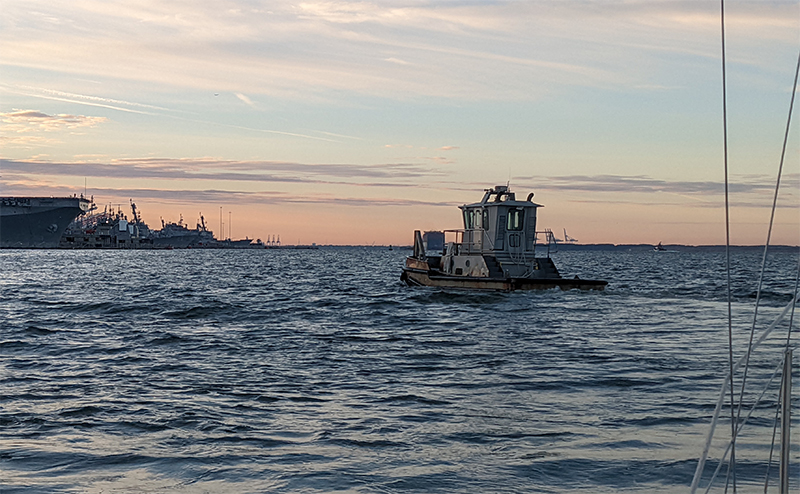
I noticed, through binoculars, that the ship had a hatch open on her side, with a ladder deployed. Then I saw on my AIS display that two McCallister branded tugs were on their way to meet the Hope. I got a nice treat watching them bring pilots aboard. Later, my friend Ed would tell me that those were the dock pilots — state pilots were already aboard the ship to assist in the ships getting into the harbor. The state pilots board offshore. Wow!
My transit into the Elizabeth River was uneventful. Minimal ship traffic, no warship traffic, and no submarines coming in or out of the harbor. Just a calm sunrise. As I saw the rows of warships parked in the naval base, I realized I finally arrived at my first real port of call. This was the first time I felt like I was truly away from home. Prior to this, it just felt like a day-sail gone wrong.
When you are solo sailing, you experience emotions to a greater degree of amplitude. All the highs feel more ecstatic. For example, me shouting in defiance after I took the sails down in the storms yesterday. Today, this manifested in a strange way. I saw a huge flock of geese flying north in a big vee formation. Shortly after, I saw a stray, lone goose flying frantically in the same direction. This made me feel sad, and I worried for the bird. Will it catch up to its friends? Or will it wander alone, forever lost? Am I alone and wandering, much like this goose?
Ed had just gotten to work, skippering one of the tugs at his workplace. I was going right by him at the navy piers, so he came close and we took pictures of each other. It was the first time I talked to someone in person since I left Solomons. I was tired, but it energized me. Ed did a hilarious spin on his tug. Ever since seeing this, I’d go on for many months cracking myself up doing the same turn, no matter what boat I was in.
I put my anchor down at nine in the morning at Hospital point, the closest thing to home since I actually left home. I did not get up until three in the afternoon. It took me about an hour to pack for shore and deploy my tender. I had thoughtlessly put all my spare fuel into Sonora’s tank, so I had to make it to the Tidewater Marina and get a few gallons of fuel for the dinghy. Fortunately, I had about a liter of fuel left in the outboard, and it started right away. Ed actually stopped by with a full LPG tank for me, which I’d thoroughly enjoy many hours later, writing parts of this journal.
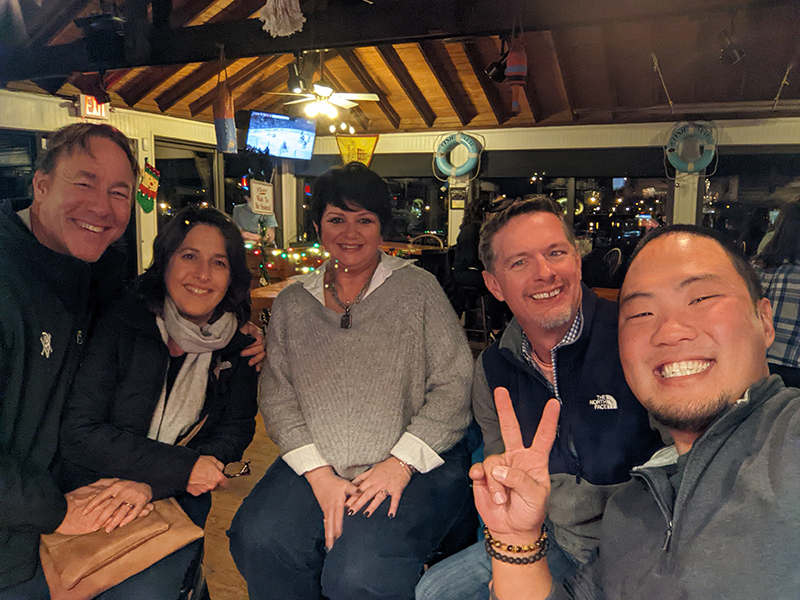
A bit later, I met up with Ed, Aimee, Ben and Christina and had a few drinks and a meal together. They are all sailors from the Hampton yacht club. It was great time seeing them again. I’m so happy I have these friends in the Hampton Roads area. It makes me feel like this place is a second home. Sleep came easily that night, but my body is not used to this yet. I kept getting up at different parts of the morning. The following day, I had a lot of tasks that needed to be done. Provisioning was one, but now I had to find a replacement shackle for my reef point. In the hardly lucid moments between sleep, the boats cabin was an embrace. Warm, dry, and cozy. I didn’t miss my bedroom at all!
2 thoughts on “As Day Breaks, I’m home (again) (11/29/21 Chesapeake Bay, VA)”
Enjoyed reading of your adventures sailing from Solomons; reminds me of the night now so many years ago when I agreed to skipper a girlfriend’s boat from Annapolis to Alexandria She had inherited the 46′ gaff-headed Famouth Cutter (wooden, circa 1902), but didn’t know how ro sail! So the two of us left Annapolis Harbor about 10 p.m. on a beautiful moonlit night, wind out of the north, and a run all the way down the bay to the Potomac and up inside to Smith Creek by sunrise. Nothing unusual happened, just pure pleasure that we had done it, with strange boat, 11 tons, drew 6′, totally ignorant!
Hi Taylor! That is so cool — I, like others, initially thought you were talking about the little FG Lyle Hess boat. That must have been such an experience to sail on a boat like that. I actually have never sailed up the Potomac – the most was getting into Coan creek to duck out of a storm on the return trip from this cruise. There is a huge chunk of the Potomac I haven’t explored yet!